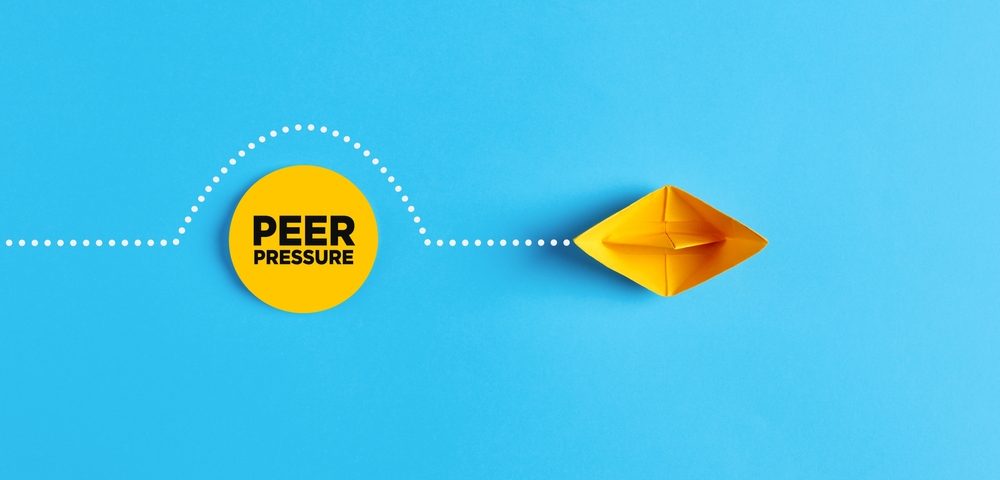
Tech-Free Travel
January 29, 2022
Key to Prevention
February 1, 2022First, of course, parents and caregivers need to remember that peer pressure—defined more or less as an influence that a peer group or individual exerts in order to change others’ attitudes, actions or values—is something that’s been around as long as humans have. It’s generally experienced by most everyone, says psychologist Vivian Seltzer, M.S.W., Ph.D., professor emerita at the University of Pennsylvania and the author of three books, including “Peer-Impact Diagnosis and Therapy: A Handbook for Successful Practice with Adolescents.” There are plenty of occasions in which it’s a positive influence as well, such as when students encourage each other to study for a test or pull their grades up.
Peer pressure typically begins in middle school and lingers through high school, but it’s also a transitional thing, affecting some kids at one age and others at different times in their lives, she says.
“It’s important for parents to realize it’s a process of growth,” Seltzer explains, adding that it’s also good to remind your child that the adolescent and teen years are a huge time of physical, emotional and social growth. These are also the years when a child is apt to try out new things, from good and less-than-desirable behaviors to sports, music genres and, yes, even friends.
“Kids have to understand that, sometimes, their best friend will not be their best friend anymore,” Seltzer says. “That’s natural. Don’t be worried if your kid gets dropped because they may be the dropper in six months or so.”
Being there
With all the turmoil that can result from the emergence of peer pressure in your child’s life, it’s more important now than ever for parents to be there for their kid—even if they aren’t the first ones the child turns to.
By the time kids get to middle school, peer relationships are their No. 1 priority, Shure says, and children who succumb to peer pressure often are those same youngsters who weren’t able to form friendships, the kinds that are constructive and rewarding, when they were younger.
Seltzer says parents need to accept that they’re going to be second fiddle to their kid’s friends awhile; it’s normal, but it doesn’t mean parents lose their parental role.
“An important function of parents is to reduce kids’ internal pressure,” she says. “They’re comparing themselves to so many kids that they feel like a loser every day, so support them and reassure them. Patience is the name of the game; patience, love and understanding.”
Of course, if a child is unhappy most of the time, a meeting with a counselor or therapist is in order, she says. Similarly, if your child’s grades begin to slip, talk with teachers about the atmosphere in the classroom and ask if there are one or more positive aspects about your student that the teacher can stress out loud.
Marion Lindblad-Goldberg, Ph.D., clinical professor of psychology in the Department of Psychiatry at the University of Pennsylvania School of Medicine and director of the Philadelphia Child and Family Therapy Training Center Inc., notes that the less a child has going for them family wise, the more important a peer group will be. So make it a point to be an interested and engaged parent, she said, and ask questions that probe your child’s feelings such as:
Tell me today what happened that you felt good about?
What went well today and what didn’t?
How do you feel about the way you handled things (with your friend, the math teacher, etc.)?
To learn more add the Peer Pressure Issue to your MASK Library
MASK the Parenting Magazine a quarterly publication providing solutions for Today’s Families.
The parenting manual offering solutions to the modern-day challenges families face. From Pre-K
through College stay up to date on the modern day issues families face.
Are you up to date on the issues your child is facing?
MASK Mothers Awareness on School-age Kids offers parenting solutions for today’s families. MASK tackles important topics – from drugs and alcohol to bullying and Internet safety -and gives students, parents and the community the knowledge and tools to manage these potential challenges.
Subscribe today! https://www.tools4teaching.com/product/mask-the-magazine/
Download and share the MASKmatters app now! Made for children, parents, teachers and in Spanish.
Have solutions at your fingertips
Available free on apple and google play links below
Apple https://apps.apple.com/us/app/maskmatters/id1482305692
Google Play
https://play.google.com/store/apps/details?id=com.maskmatters.maskmattersapp&hl=en_US&gl=US





